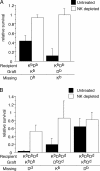Natural killer cell education in mice with single or multiple major histocompatibility complex class I molecules
- PMID: 15809355
- PMCID: PMC2213126
- DOI: 10.1084/jem.20050167
Natural killer cell education in mice with single or multiple major histocompatibility complex class I molecules
Abstract
The ability of murine NK cells to reject cells lacking self MHC class I expression results from an in vivo education process. To study the impact of individual MHC class I alleles on this process, we generated mice expressing single MHC class I alleles (K(b), D(b), D(d), or L(d)) or combinations of two or more alleles. All single MHC class I mice rejected MHC class I-deficient cells in an NK cell-dependent way. Expression of K(b) or D(d) conveyed strong rejection of MHC class I-deficient cells, whereas the expression of D(b) or L(d) resulted in weaker responses. The educating impact of weak ligands (D(b) and L(d)) was further attenuated by the introduction of additional MHC class I alleles, whereas strong ligands (K(b) and D(d)) maintained their educating impact under such conditions. An analysis of activating and inhibitory receptors in single MHC class I mice suggested that the educating impact of a given MHC class I molecule was controlled both by the number of NK cells affected and by the strength of each MHC class I-Ly49 receptor interaction, indicating that NK cell education may be regulated by a combination of qualitative and quantitative events.
Figures






References
-
- Kärre, K., H.G. Ljunggren, G. Piontek, and R. Kiessling. 1986. Selective rejection of H-2-deficient lymphoma variants suggests alternative immune defence strategy. Nature. 319:675–678. - PubMed
-
- Cerwenka, A., and L.L. Lanier. 2001. Ligands for natural killer cell receptors: redundancy or specificity. Immunol. Rev. 181:158–169. - PubMed
-
- Vilches, C., and P. Parham. 2002. KIR: diverse, rapidly evolving receptors of innate and adaptive immunity. Annu. Rev. Immunol. 20:217–251. - PubMed
-
- Gunturi, A., R.E. Berg, and J. Forman. 2004. The role of CD94/NKG2 in innate and adaptive immunity. Immunol. Res. 30:29–34. - PubMed
-
- Long, E.O. 1999. Regulation of immune responses through inhibitory receptors. Annu. Rev. Immunol. 17:875–904. - PubMed
Publication types
MeSH terms
Substances
LinkOut - more resources
Full Text Sources
Other Literature Sources
Molecular Biology Databases
Research Materials
Miscellaneous

